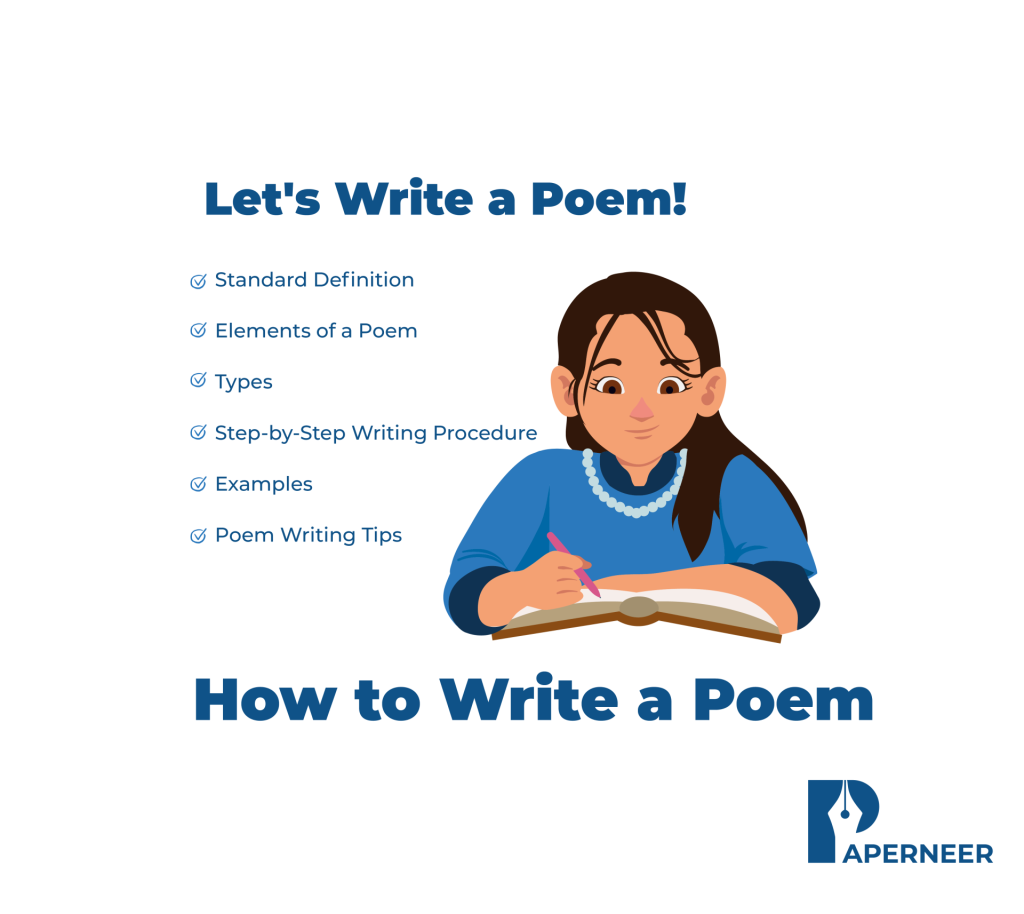Capstone Project – A Complete Guide A capstone project is sometimes the...
Read MoreHow to Write a Poem?

Writing poetry can be an unbelievably bountied expertise, providing you the prospect to specify your emotions, thoughts, and creative thinking during a summary, which is nevertheless a powerful method. Whether or not you’re a beginner or trying to refine your skills, knowing the basic aspects of poetry is important. During this guide, we’ll cover everything from what a literary work is to numerous sorts of poems and tips to write captivating ones. If you’re curious about how to write a poem, this diary can walk you through the fundamentals and a lot of advanced techniques for crafting purposeful poetry.
In this blog brings you:
What is a Poem?
A poem could be a literary work that expresses feelings, ideas, or stories in a targeted and infrequently swinging type. In contrast to regular prose, poetry tends to make use of heightened language, rhyme, meter, and different rhetorical options to evoke emotions or paint vivid pictures within the reader’s mind. Poems are often short or long, straightforward or advanced. However, all of them aim to speak one thing profoundly, whether or not through words, rhythm, or silence.
Elements of a poem
To understand how to write a poem effectively, it’s vital to know the core components that form a poem:
- Theme: This can be the central plan or subject of the verse form. It might be love, nature, sorrow, or other abstract or concrete construct.
- Structure: This refers to the layout or type the verse form takes. It will embrace line breaks, stanzas, rhyme schemes, or poems.
- Rhyme: Some poems use rhyme schemes, whereas others don’t. A rhyme theme could be a pattern of rhymes at the top of every line (e.g., ABAB).
- Rhythm: The beat or pace of the verse form that is commonly determined by the quantity of syllables or stressed and unaccented syllables in every line.
- Imagery: Vivid descriptions that charm the senses and paint photos within the reader’s mind.
- Tone: The mood or perspective sent through the language and structure of the verse form.
- Figurative Language: Tools like metaphors, similes, personification, and figure of speech that add depth and assuming to the verse form.
Types of Poems
There are many types of poems, and everyone has its own rules and structure. Here are a few popular ones:
- Sonnet: A 14-line literary composition, typically written in iambic Verse, with a selected rhyme theme.
- Haiku: A conventional Japanese style of poetry consisting of 3 lines with a language unit pattern of 5-7-5.
- Limerick: A Gilbertian five-line literary composition with a particular rhythm and rhyme theme (AABBA).
- Free Verse: a sort of literary composition that doesn’t follow any specific rhyme or meter, leaving larger inventive freedom.
- Ballad: A narrative literary composition, usually written in quatrains, that tells a story, usually concerning love, tragedy, or journey.
- Acrostic: A literary composition wherever the primary letter of every line spells out a word or message.
Use of Literary Devices in Poems
One of the key aspects of learning a way to write a literary composition is incorporating literary devices. These tools facilitate conveying that means and feeling a lot more powerfully. Here are some unremarkably used literary devices in poetry:
- Metaphor: Scrutiny of two things while not victimization “like” or “as.” for instance, “Time could be a criminal.”
- Simile: A comparison victimization “like” or “as.” for instance, “Her smile was as bright because of the sun.”
- Personification: Giving human characteristics to non-human things. For instance, “The wind unvoiced through the trees.”
- Alliteration: The repetition of consonant sounds at the start of words. For instance, “Peter Piper picked a peck of preserved peppers.”
- Onomatopoeia: Words that imitate sounds. For instance, “buzz,” “crash,” or “whisper.”
How to Write a Poem for Beginners?
For beginners, beginning with a poem or straightforward rhyming poetry is a good thanks to ease into writing. Here are some basic steps to follow:
- Choose a Theme: Begin with one thing that conjures up you—whether it’s a memory, a feeling, or a picture.
- Brainstorm: Jot any words, phrases, or concepts that return to mind associated with your theme.
- Decide on a Structure: You’ll favor following a conventional structure or electing a poem if you favor flexibility.
- Write: Begin writing your verse form, specializing in expressing your thoughts clearly and creatively.
- Revise: When writing, browse through your verse form—Hunt for places where you’ll improve your representational process, tone, or rhythm.
How to Write a Short Poem?
Writing short poems may be a nice exercise in brevity and impact. A brief poem will convey powerful emotions or thoughts in a mere couple of lines. Here are some tips:
- Be Concise: Select every word rigorously. Each word in a short poem ought to serve a purpose.
- Focus on One Idea: Limit your verse form to at least one theme or plan, permitting it to develop clearly and easily.
- Use robust Imagery: Since the verse form is brief, vivid imagination is crucial to form control.
- Use Brevity for Emotion: Short poems will pack an emotional punch. Create the use of powerful language to evoke deep feelings.
How To Write a Poem: Examples
Here are some simple examples to help you get started:
Example one (Short Poem): the celebs are twinkling bright,
- In the quiet of the night.
- Dreams are withdrawing,
- In the stillness, they ignite.
Example two (Free Verse Poem): The rain falls softly,
- Whispering secrets to the world.
- Each drops a story,
- A story of a remote land.
Tips to write a captivating poem
- Read alternative poetry: Browsing varied poets can provide you with various designs and techniques.
- Write Regularly: The additional you write, the higher you may get at finding your distinctive voice.
- Use Emotion: A literary work ought to evoke feeling. Don’t be afraid to pour your emotions into the words.
- Experiment with Form: Strive for totally different varieties of poetry that suit your voice best.
- Edit Ruthlessly: Don’t hesitate to revise your work. Often, poetry becomes clearer and more impactful within the written material method.
Conclusion
Learning how to write a poem opens the door to endless artistic potential. Whether or not you like a conventional structure or relish experimenting with verse form, the foremost vital facet is to grasp your ability. Let your emotions and ideas flow freely onto the page, permitting your expression to shine through. With consistent application, you’ll discover that poetry becomes a strong means of conveying your deepest thoughts and emotions. It permits you to speak more vividly and genuinely. So, develop your pen and begin writing today—because every verse form you produce brings you nearer to mastering the art of poetic expression.
Say goodbye to Mistakes in Term Papers
Avoid Errors in Term Papers Writing a theme may be a vital tutorial task that needs careful designing and...
Read MoreUnraveling the Stories: Autobiography vs Biography
Autobiography vs Biography Understanding the excellence between autobiography and biography is crucial for...
Read More




